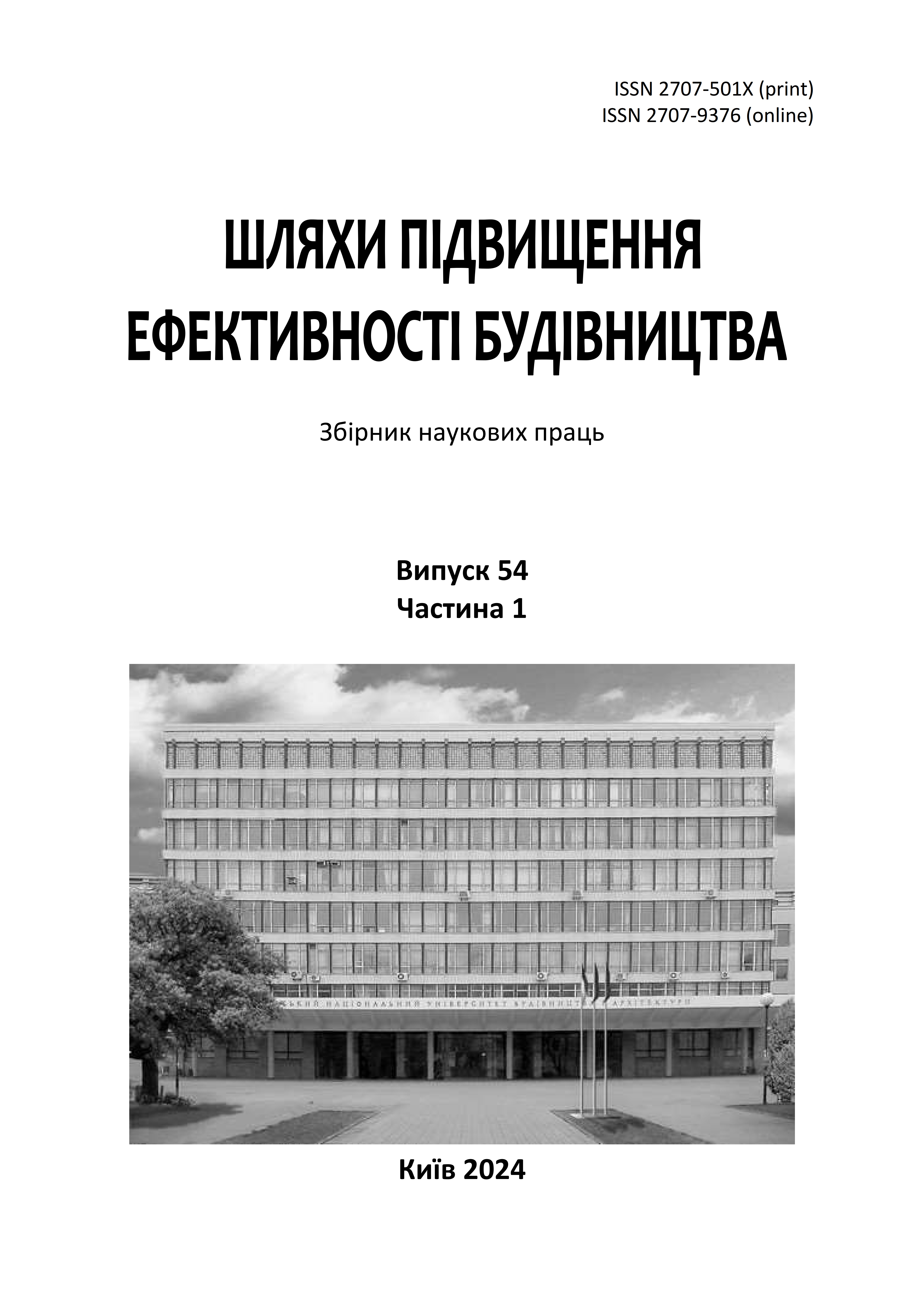Effect of nanocatalyst modification on concrete strength
DOI:
https://doi.org/10.32347/2707-501x.2024.54(1).3-13Keywords:
portland cement, glycerin, surfactants, concrete, strength, catalysisAbstract
The article presents the results of the analysis of the properties of materials based on Portland cement, polyalcohols and surfactants used in ultra-low doses, describes the results of determining the effect of ultra-low doses of glycerin and surfactants on the strength of concrete. The aim of the work is to determine the effectiveness of the use of a mixture of glycerin and surfactants in ultra-low doses during the hardening of Portland cement. The methodology of the experiments includes the following methods: analysis of studies on the use of glycerin and surfactants; standard concrete test methods; comparative analysis; systematization and generalization of foreign and domestic experience. As a result of the study, the effect of a mixture of glycerin and surfactants applied in ultra-low doses to the strength of concrete. It has been proven that in this case, the action of ultra-small doses of a mixture of glycerin and surfactants is to reduce the number of open pores in the cement stone. Experimental studies have confirmed that surfactant molecules such as hyperplasticizers or others significantly alter the pH of the water used to make concrete. Increasing the mechanical strength of the resulting concrete makes it possible to replace part of the cement with a nanopowder made of a cheaper mineral. It has been found that an increase in the water-cement ratio in a mixture of glycerol and surfactants leads to an increase in the efficiency of ultra-low doses of surfactants substances in the formation of concrete compressive strength. The highlighted scientific materials became the starting point for understanding the issue under study. The effect of ultra-low doses of glycerin and surfactants on the strength of concrete has been identified and substantiated. The results of the study can be used in the production of concrete and reinforced concrete products and structures.
References
Lee M.-G., Wang Y.-C., Chiu С.-T. A preliminary study of reactive powder concrete as a new repair material. Construction and Building Materials. 2007, Volume 21, Issue 1, Р. 182-189. DOI: 10.1016/j.conbuildmat.2005.06.024
Chiu С.-T., Huang J.-S. Highly flowable reactive powder mortar as a repair material. Construction and Building Materials. 2008, Volume 22, Issue 6, Р. 1043-1050. DOI: 10.1016/j.conbuildmat.2007.03.009
Collepardi M., Olagot J.J., Troli R., Simonelli F., Collepardi S. Combination of Silica Fume, Fly Ash and Amorphous Nano-Silica in Superplasticized High-Performance Concretes. The First National Nano Biotechnology Conference, Iran, Damghan, June 5, 2011. URL: https://www.encosrl.it/OLDSITE/pubblicazioni-scientifiche/pdf/aggiunte/22.pdf
Lahallh S.M., Absl-Halabi M., Ali M. Ali Effect of polymerization conditions of sulfonated-melamine formaldehyde superplasticizers on concrete. Cement and Concrete Research. 1988, Volume 18, Issue 4, P. 513-531. DOI: 10.1016/0008-8846(88)90044-0
Collepardi M., Valente M. Recent Developments in Superplasticizers. International Concrete Abstracts Portal, 2006, 239. Р. 1–14. URL: https://www.concrete.org/publications/internationalconcreteabstractsportal?m=details&i =18367&m=details&i=18367
Flatt R.J., Martys N., Bergström L. The Rheology of Cementitious Materials. MRS Bulletin, 2004, 29(5), 314–318. DOI:10.1557/mrs2004.96.
Hanehara S., Yamada, K. Rheology and Early Age Properties of Cement Systems. Cement and Concrete Research, 2008, 38, 175-195. DOI: 10.1016/j.cemconres.2007.09.006.
Pundienė I., Mironov V., Korjakins A., Spudulis E. Investigation of Hydration Features of the Special Concrete with Aggregates of Various Metal Particles. Key Engineering Materials. 2014. Vol. 604, pp. 297–300. DOI: 10.4028/www.scientific.net/kem.604.297.
Kara P., Korjakins A. High Efficiency Ecological Concrete. Key Engineering Materials. 2014. Vol. 604, pp. 157–160. DOI: 10.4028/www.scientific.net/kem.604.157.
Toropovs N., Bajare D., Sahmenko G., Krage L., Korjakins A. The Formation of Microstructure in High Strength Concrete Containing Micro and Nanosilica. Key Engineering Materials, 2014, 604, 83–86. DOI: 10.4028/www.scientific.net/kem.604.83.
Sahmenko G., Toropovs N., Sutinis M., Justs J. Properties of High Performance Concrete Containing Waste Glass Micro-Filler. Key Engineering Materials. 2014, 604, 161–164. DOI: 10.4028/www.scientific.net/kem.604.161
Šahmenko G., Juhņeviča I., Korjakins A. Influence of Sol-Gel Nanosilica on Hardening Processes and Physically-Mechanical Properties of Cement Paste. Procedia Engineering. 2013, Vol. 57, pp. 1013-1021. DOI: 10.1016/j.proeng.2013.04.128
Girskas G., Nagrockiene Dz., Skripkiunas G. Frost resistance of hardened cement paste modified with synthetic zeolite. Engineering Structures and Technologies. 2013, 5(1):30-36. DOI: 10.3846/2029882X.2013.777119.
Pundienė I., Pranckevičienė J., Zhu C., Kligys M. The role of temperature and activator solution molarity on the viscosity and hard structure formation of geopolymer pastes. Construction and Building Materials. 2020, Volume 272: 121661. DOI: 10.1016/j.conbuildmat.2020.121661.
Pundienė I., Kligys M., Šeputytė-Jucikė J. Portland Cement Based Lightweight Multifunctional Matrix with Different Kind of Additives Containing SiO2. Key Engineering Materials. 2014, 604, 305–308. DOI: 10.4028/www.scientific.net/kem.604.305.
Penttala V; Vornanen C. Reactive powder based concretes: Mechanical properties, durability and hybrid use with OPC. Cement and Concrete Research. 2008, Vol. 38, Issue 10, Р. 1217-1226. DOI:https://doi.org/10.1016/j.cemconres.2008.03.013
Gilliland S.K. Reactive Powder Concrete (RPC), A New Material for Prestressed Concrete Bridge Girders. Building an International Community of Structural Engineers, 1996, Vol. 1, Р. 125-132.
Termkhajornkit P., Nawa T., Nakai M., Saito T. Effect of fly ash on autogenous shrinkage. Cement and Concrete Research. 2005, 35(3):473-482. DOI: 10.1016/j.cemconres.2004.07.010.
Технологія виготовлення цементу. URL: http://jak-zrobyty.pp.ua/8768-tehnologya-vigotovlennya-cementu.html.
Downloads
Published
How to Cite
Issue
Section
License

This work is licensed under a Creative Commons Attribution 4.0 International License.
Authors who publish with this journal agree to the following terms:
- Authors retain copyright and grant the journal right of first publication with the work simultaneously licensed under a Creative Commons Attribution License that allows others to share the work with an acknowledgement of the work's authorship and initial publication in this journal.
- Authors are able to enter into separate, additional contractual arrangements for the non-exclusive distribution of the journal's published version of the work (e.g., post it to an institutional repository or publish it in a book), with an acknowledgement of its initial publication in this journal.
- Authors are permitted and encouraged to post their work online (e.g., in institutional repositories or on their website) prior to and during the submission process, as it can lead to productive exchanges, as well as earlier and greater citation of published work (See The Effect of Open Access).

